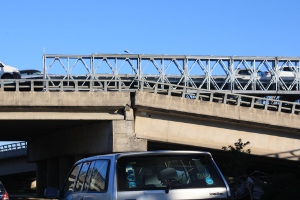 Just how well-built are our buildings and bridges?
Just how well-built are our buildings and bridges?
The next big one. Many of us are trying to avoid even thinking about it. But the reality is it is going to happen. California has hundreds of fault lines. In fact, the Hayward fault, which runs under the east bay, is labeled one of the most dangerous faults in the country because it runs right under some of the busiest hospitals, freeways and Bart lines in the Bay Area. Just how well-built are our buildings and bridges? Well, when a big quake happens somewhere else, like the massive 8.8 magnitude quake in Chile last month, it offers a chance to find out. Chile, a highly prone quake region, has built many of their modern mid-rises and high-rises to U.S. building standards. So when February's big quake and tsunami hit, engineers and geoscientists rushed down before the evidence could get cold.
According to the Earthquake Engineering Research Institute (EERI), construction following U.S. building codes held up well - it was the buildings where contractors took short cuts that didn't do so well. Chile's standards for strengthening bridges has not been adequate and many bridges collapsed in the quake, especially older ones. A new highway system is being planned in Chile including many bridges and many of those new bridges will follow the American Association of State Highway guidelines. Passive energy dissipation devices, friction bearings and other cutting edge bridge technologies are being considered. There was also bad news for Chilean vintners which could offer lessons for the Northern California wine industry. Standard racks, used to stack wine barrels, collapsed and rivers of wine drained away. Some vintners lost an entire year of production. This is a big hit to an important sector of Chile's economy and the value of good Chilean wine worldwide.
California is lagging on a 2013 deadline to retrofit hospitals and many owners are asking the state to postpone that deadline. Chile's quake was a lesson for us about what happens when hospitals are not retrofitted. Twenty hospitals had to be evacuated in Chile after the quake and ten were severely damaged. U.S. engineers visiting Chile were also reminded of the deadly potential of non-structural hazards, such as pipes, water heaters, furniture and bookshelves that can become violently unleashed in a massive quake.
UC Berkeley Civil Environmental Engineering professor Jack Moehle, with EERI, says one of the biggest things California needs to do is get serious about it's retrofitting of old housing stock. Nearly 80-percent, he says, doesn't conform to standards. Older wood frame, multi family homes with a parking garage, or some kind of open space on the first floor, are vulnerable as are apartment buildings built over ground level parking and mid-rise buildings made from old concrete standards. We have not seen a really big earthquake here that tests our infrastructure. Many seismologists say it is not only inevitable, it is overdue. Are you ready? Check out the California Seismic Safety Commission site as well as the USGS Earthquake Hazard Program Website.
